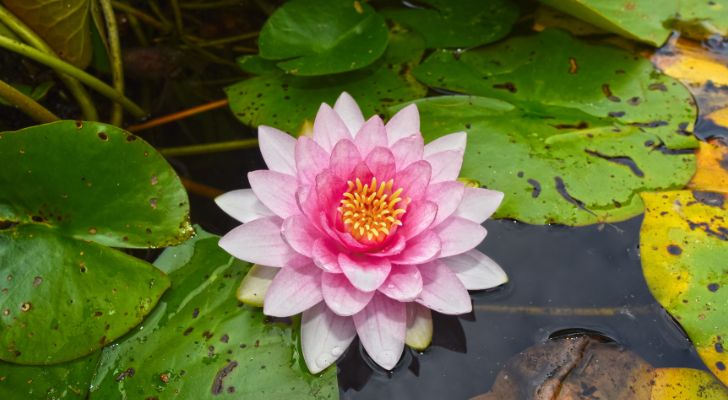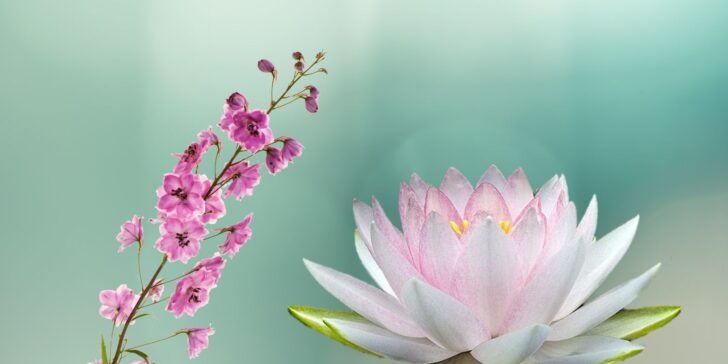Entering the second half of the year, we’re presented with the vibrant birth flowers of July: Larkspurs and water lilies!
But aside from being colorful, both flowers also play a crucial role in our ecosystem, with larkspurs attracting pollinators and water lilies preventing algae blooms.
The fun doesn’t stop there, of course, as there’s more to know about July’s birth flowers, from their unique characteristics to which one can be used to make a good popcorn substitute!
So, keep reading to discover 20 fascinating facts about larkspurs and water lilies.
10 Facts About Larkspurs

Larkspurs belong to the Delphinium genus, a group of around 365 species of flowers. All members of this genus, including all larkspur variants, are toxic to humans and livestock.
Blue is the most common color for larkspurs, but they can also be seen in red, pink, white, yellow, and violet.
Annual larkspurs, such as the rocket larkspur, are also classified under another genus called Consolida. This is why rocket larkspurs are either called Delphinium ajacis or Consolida ajacis.
Speaking of annual larkspurs, they typically grow up to 2 feet (61 centimeters) tall. Perennial larkspurs, on the other hand, can grow as tall as 6 feet (183 cm)!
They’re called larkspurs because of their long, pointy petals, resembling a meadowlark bird’s claws or the silver spur from a knight’s boots.
Larkspurs are good for more than just looking at; they contain lots of sweet, sweet nectar that attracts birds and bees.
There’s a city in California called Larkspur. Legend has it that the founder’s wife named it after mistaking some lupine flowers found nearby for larkspurs!
Larkspurs have a long history in folklore. They’re often associated with protection against evil spirits and promoting love, youth, and positivity.
They’re native to the United States and Europe, with gardens from England starting to have them in the mid-1500s and gardens from the US around the mid to late 1700s.
According to Greek mythology, larkspurs emerged from the blood of Ajax, a heroic figure in the Trojan War. Where his blood spilled, beautiful larkspurs sprang up.
10 Facts About Water Lilies

Water lilies float because of air pockets within their stems and lily pads (leaves). They still have roots, of course, which are connected to their leaves by long creeping stems.
Bangladesh’s national flower, the white water lily, is also featured in its national emblem.
Aside from white, water lily flowers can appear in pink, red, orange, yellow, purple, and blue. Water lily pads can also be green or red, although this changes depending on the temperature rather than species.
The seeds of water lilies can be popped like popcorn, and some even claim they make a great alternative to potato chips, especially since they’re low in calories and gluten-free.
Water lilies symbolize resurrection within Hinduism and Buddhism, as their flowers open in the morning and close at night. Additionally, Buddhists associate them with enlightenment as they grow from the muddy waterbed.
Water lilies like shallow or slightly deep waters, like ponds and lakes. You won’t ever see them growing in rivers or oceans since they’re freshwater plants and prefer still or slow-moving bodies of water.
Not all water-floating plants are water lilies, as some are lotuses. An easy way to tell them apart is by looking at their flowers; water lilies have pointed petals, while lotus flower petals are more rounded.
The largest water lily species belong to the genus Victoria, named after Queen Victoria of Britain. The largest species is the Bolivian water lily (Victoria boliviana), whose leaves can grow up to 9.8 feet (3 meters) wide!
Frogs love to sit on water lilies for a couple of reasons: they provide a great perch to hunt from, but they also sink below water under their weight, allowing the frogs to stay hydrated!
Water lilies can help reduce excessive algae buildup in ponds. This is because they provide a lot of shade to the water, and algae thrive in sunny conditions.
July’s birth flowers thrive in different environments, one on land and the other in water, yet together, they hold meaningful places in different cultures and religions.
Like July babies, these flowers also have something interesting to show, like the larkspur’s unique pointy petal and the water lilies’ poppable seeds.
So, to those with July birthdays, let this be a reminder of how special you are and why your birth flowers are nature’s perfect reflection of you!


















